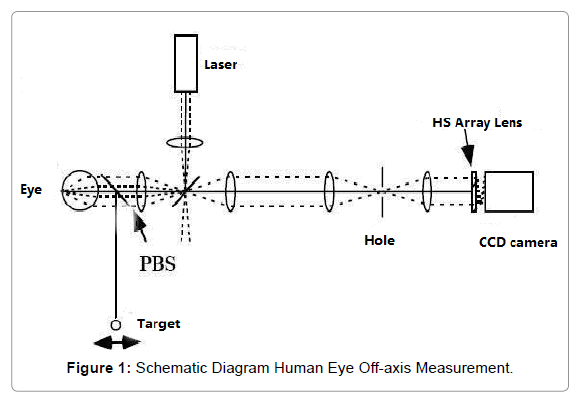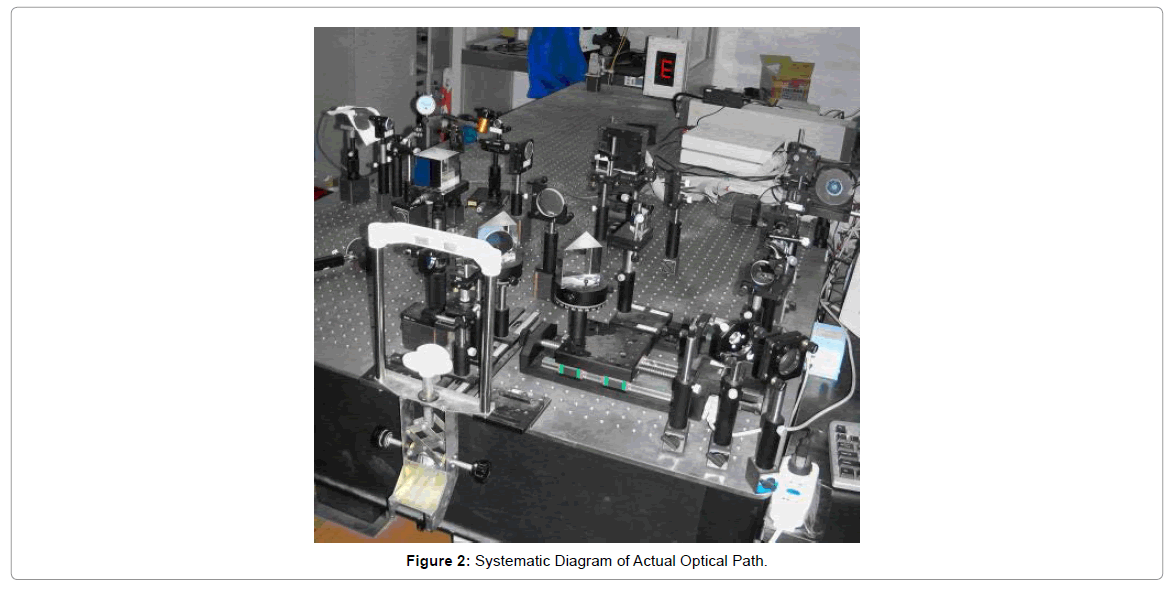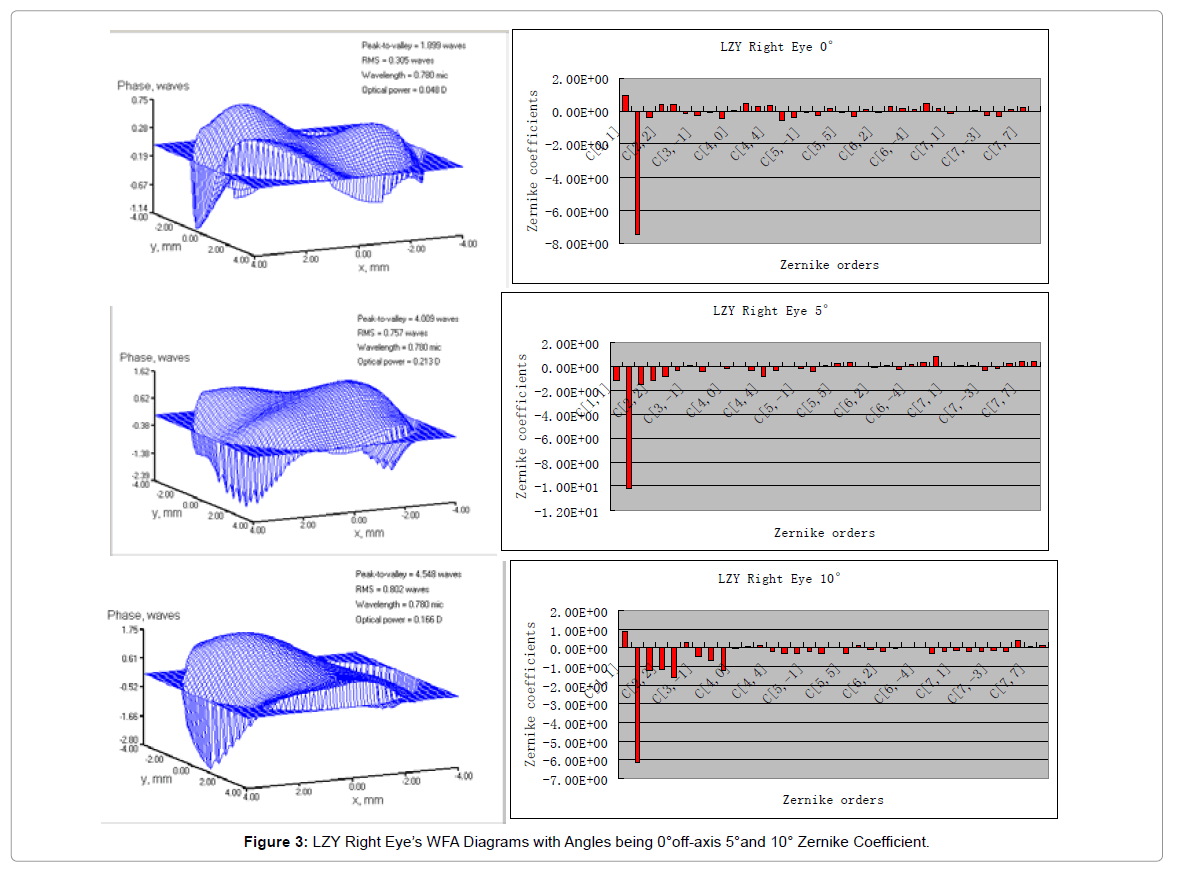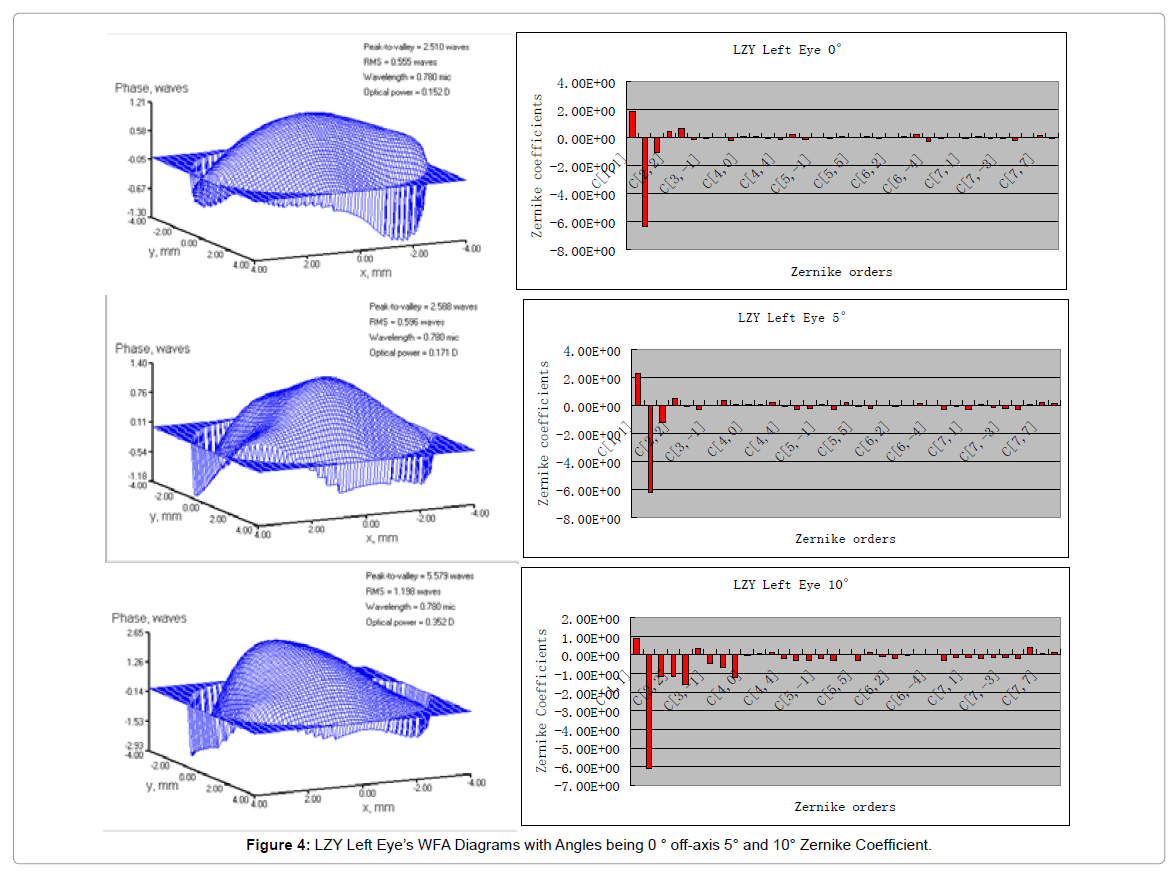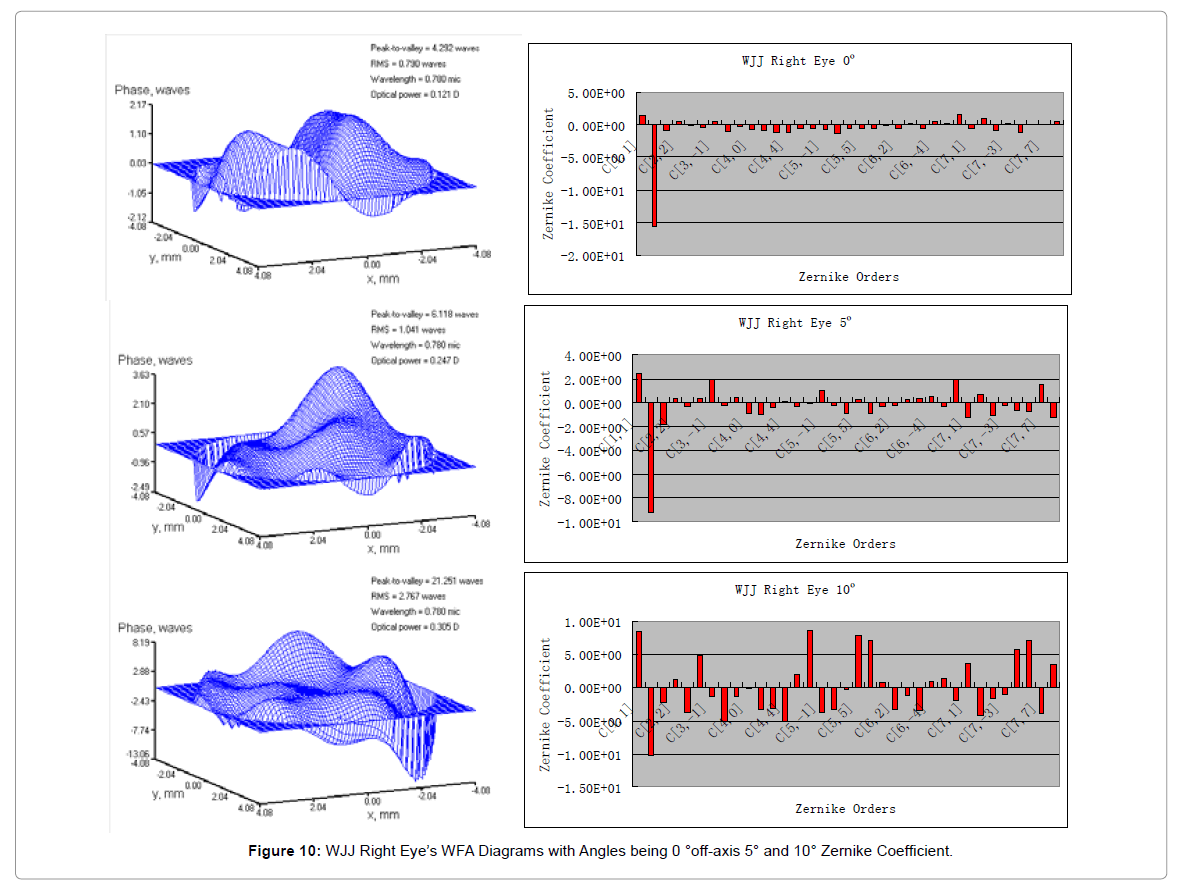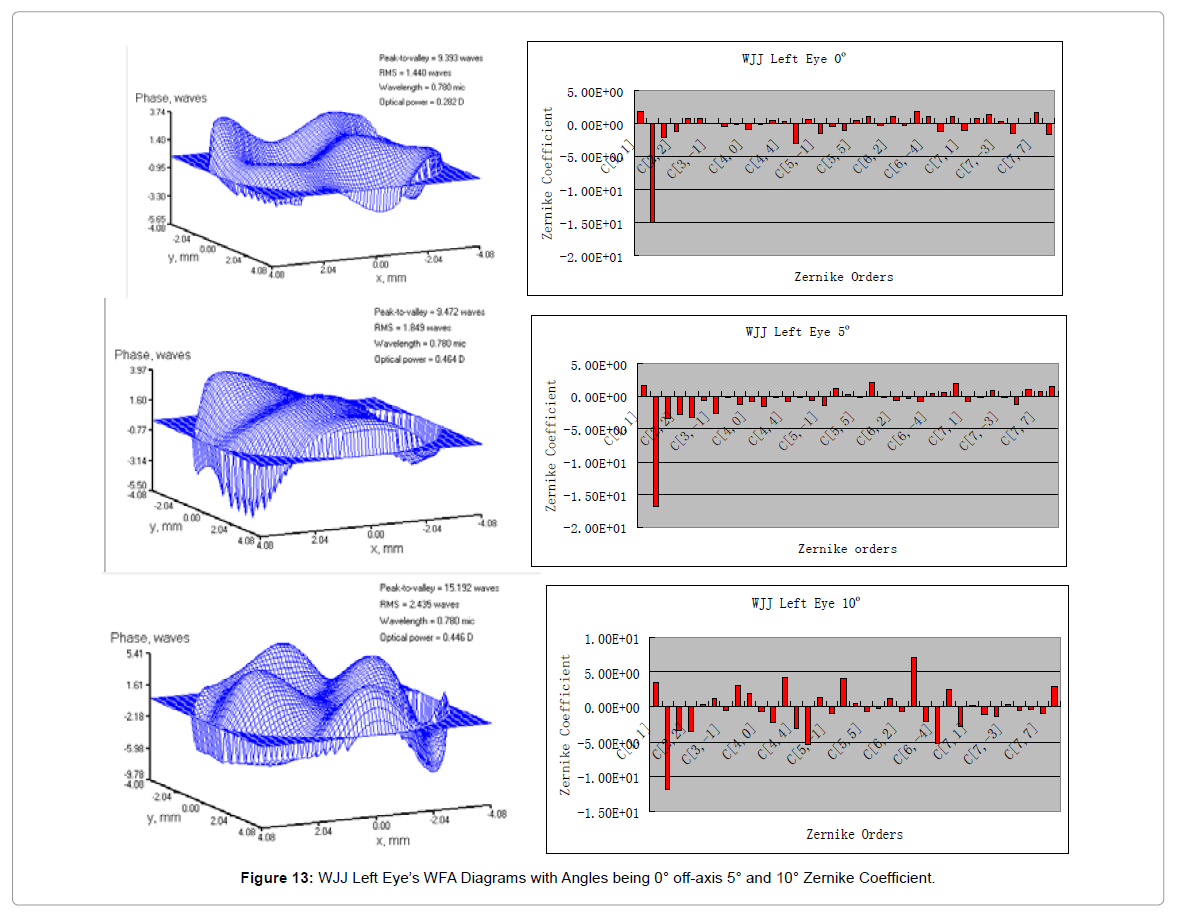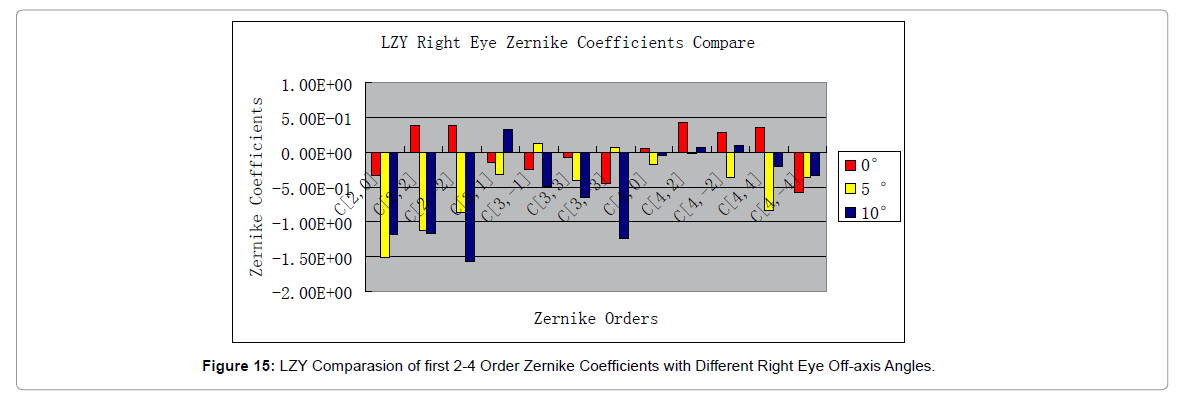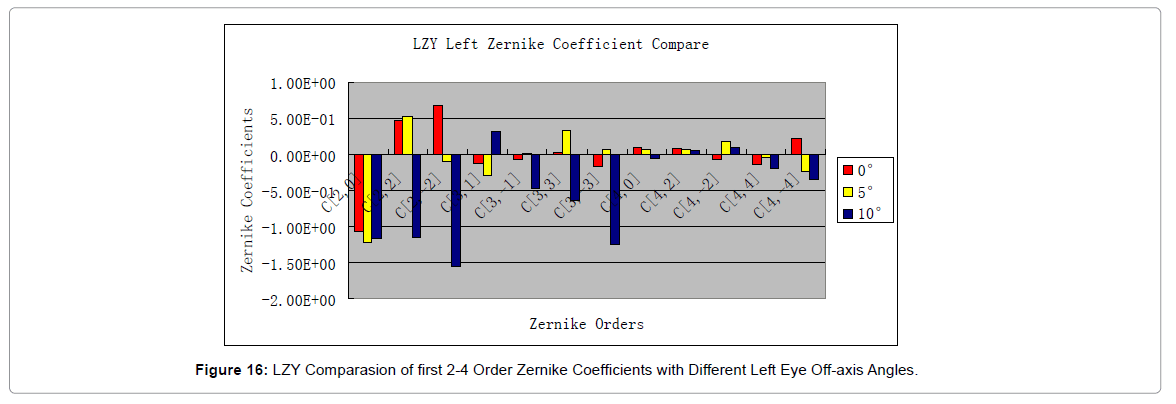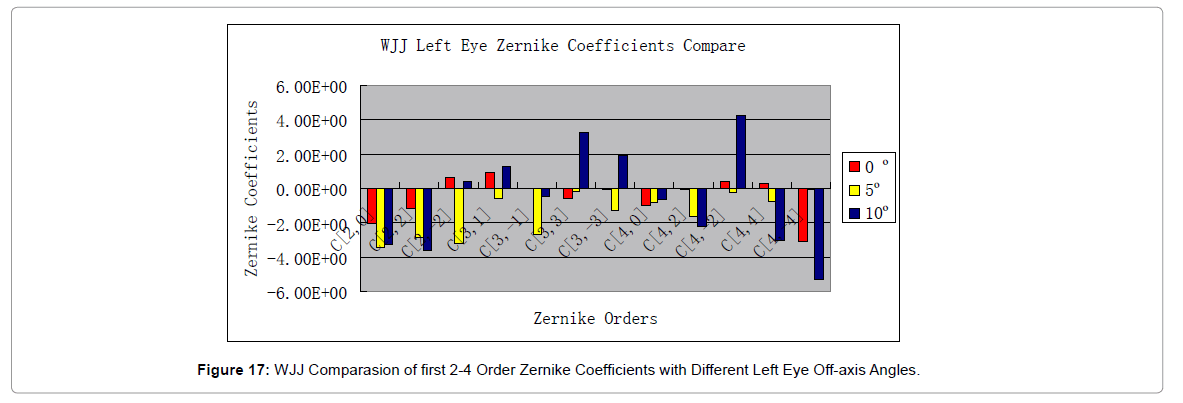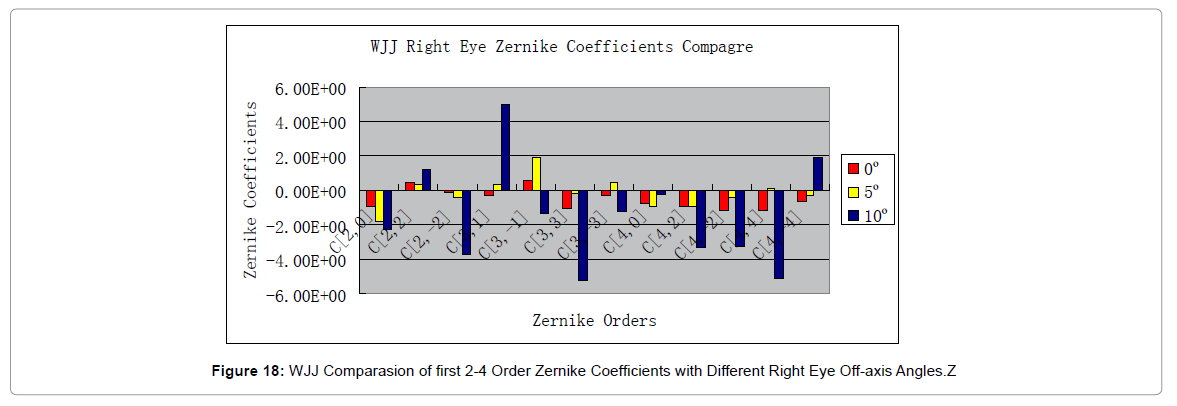Analysis on Visual Imaging Quality Affected by Human Eye's Higher Order Aberration Measurement via Off-axis Wavefront
Received: 25-Oct-2016 / Accepted Date: 20-Dec-2016 / Published Date: 27-Dec-2016 DOI: 10.4172/2476-2075.1000121
Abstract
This paper mainly discusses the system design and establishes the experimental system which conducts realtime off-axis measurement of the human eye’s aberration. The target is installed in the optical path of human eye objective measuring system. When observing the target, the human eye adjusts itself to a relaxing state so as to conduct measurement. The target being observed conducts movement vertical to optical axis within its field range, and then realized the off-axis aberration measurement. Research data show that only when normal incidence of the light occurs can changes the human eye’s aberration which caused by measuring errors be minimized. Data from all the objects reveal that second order aberration has the largest proportion among all the aberrations and does not show significant change within the increased off-axis angle in the vision field. Third order aberration increases with the increase of off-axis angle in the vision field. Fourth order aberration shows no obvious increase except the first item. High order aberrations for fifth order and above do not change much with the increase in off-axis angle in the field range. Meanwhile, the proportion of fifth order or above aberrations is the smallest among all the objects’ aberrations. The study results demonstrate that it is the aberrations of the former four orders that have a significant affect on human eye. With regard to off-axis aberration, third order and fourth order affect human eye imaging quality significantly. On the contrary, the high order aberrations of fifth order and above have a minor influence on human eye imaging quality.
Keywords: Hartman shack sensor; Off-axis wavefront measurement; High-order Aberration; Visual
6933Introduction
In the 1990s, human eye’s wavefront aberration measurement technology achieved rapid development. Williams DR etc. proposed two indirect wavefront aberration measurement methods, namely, interferometry and double optical path methods [1-5]. The former obtains human eye’s Modulation Transfer Function (MTF) by making use of interference that produces interference fringes with different aerial modulation degrees while the latter obtains MTF via irradiating ideal spherical wave into eye pupil, receiving wave-front information carrying aberration reflected from human eye via CCD (Charge Coupled Device), and analyzing its image. Instead of directly obtaining human eye’s WFA (wave-front aberration), the two methods can only obtain MTF function used for human eye imaging quality assessment. Also, the relatively complicated measuring equipment limits the further development of the two methods [6,7].
In early 1990s in Germany, Liang proposed measuring human eye WFA via Hartmann-Shack Sensor (HSS) [8], which has great influence on the visual measurement research. When pursuing his Doctor’s degree in University of Heidelberg, Germany, Liang attempted to measure human eye aberration via HSS in order to improve Ophthalmoscope resolution and succeeded. Liang’s team made some improvement and developed Hartmann-Shack Sensor (15 × 15 mm) composed of two groups of cylindrical mirror array vertically arranged. Such a method has now become the most frequently used technology in measuring eye aberration and has been wide applied to researches in visual science.
Institute of Modern Optics in Nankai University and Chengdu Institute of Optics and Electronics in Chinese Academy of Sciences are the two institutes mainly working on wave aberration measurement and correction. The former’s major research area is the measuring quality improvement of HSS, etc. while the latter has made fruitful research in areas such as principles of HSS measurement, wave-front sensor lens array manufacture, and AO (Adaptive optics), etc. In 2005, the project named “New Measuring Equipment for Living Human Eye Retina Resolution Imaging and High Order Aberration” jointly conducted by Chengdu Institute of Optics and Electronics and Mai Ke Company were evaluated by Chinese Academy of Sciences in Chengdu. This project developed two equipments, namely, Living Human Eye Retina Selfadapative Optical Imager and Hatmann Measuring Instrument for Human Eye Aberration which is the first objective human eye aberration measuring instrument based on Hatmann principles in China. The instrument can measure both high order and low order human eye aberration, calculate 65 Zernike aberration coefficients, human eye point spread function, and Strehl modulation transfer function.
In 2006, Nanjing Aeronautics and Astronautics University and Suzhou Liu Liu Visual Technology Co. Ltd. jointly developed subjective aberration equipment. In 2007, a combination of objective and subjective visual optical analysis system was proposed by Shanghai Jiaotong University [9]. In 2008, University of Shanghai for Science and Technology creatively proposed objective and subjective combined human eye aberration measuring method based on information fusion technology [10,11]. It was a method including both subjective and objective measurement in the optical path. More human eye aberration data were obtained by the method of information fusion and more positive results were achieved.
The above mentioned measuring methods are all based on on-axis field of view. However, human eye aberration changes caused by off-axis field of view have certain impact on visual imaging [12-16]. Although research [17-21] has been done on aberration characteristics change within large field of view (plus or minus 50 degrees), research within small field of view has never been done. In spite of the fact that generally speaking, human eye has a relatively large view angle that can reach 150 degrees, the clear viewing area is within retina’s macular region, especially fovea centralis of macular region (corresponding angle being 6-8 degrees). The remaining areas have a very low resolution. Therefore, we mainly focus on characteristic changes of human eye WFA when the scope of off-axis field of view increased from 0 degree to 5 degrees and 10 degrees.
Hartmann-Shack Measurement Principle and Zernike Wave-front Reconstruction
HS method is the most widely used approach in measuring human eye WFA. HS Principle is a WFA measuring method firstly proposed by Hartmann and later improved by Shack. The basic principle of Zernike is dividing a complete wave-front into several small areas via lens arra. The irradiating wave-front leaves a series of focal points on the focal plane while passing the lens array [22-26].
WFA’s local slope can be measured by the HSS. Complete WFA can be obtained by restructing algorithm using local slope, which can be presented via Zernike polynomial as follows:
 (1)
(1)
In the equation, “n” means the highest number order of the reconstructed Zernike polynomial. Here, ak is section k of Zernike polynomial coefficient. Zk is section k of Zernike polynomial. Partial derivative of wave-front slope on subaperture can be shown as:
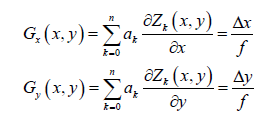 (2)
(2)
Gx and Gy means slopes in x and y directions, respectively. Suppose wave-front sensor has m subaperture, wave-front restructuring is done using the first N section of Zernike polynomial.
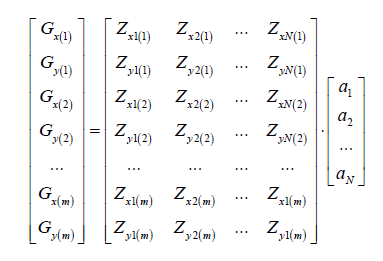 (3)
(3)
The above equation is shown in matrix form:
G=Z·A (4)
Here, G is wave-front slope vector. Z is matrix reconstruction of 2 m×N, the volume of which is decided by the number of micro lens in wave-front sensor and measuring area. A is coefficient vector of Zernike polynomial in order N. Minimum norm solution of vector A in the least square can be calculated by means of generalized inverse Z+ of wave-front matrix reconstruction Z, which is calculated by wave-front vector G measured by HSS.
A=Z+·G (5)
Complete wave-front can be achieved by calculate the coefficient vector A of Zernike back to wave-front polynomial expansion.
Building Measuring System
The experimental system establishment of off-axis measurement of human eye aberration requires realization of objective measurement which without regard to human being’s subjective influence. The measurement is done via information reflected by human eye and subjects’ adaptive cooperation. There is an observing object in the system which moves within certain field of view. Accordingly, human eye moves with the object within the field. In this way, human eye aberration in different off-axis angles can be measured and the aberration can be analysed. The system is a complex combination of optics, mechanics and electronics which requires coordination of each section. Figure 1 is the schematic diagram of human eye aberration offaxis measuring system based on HSS.
Figure 1 Components in Schematic Diagram Human Eye Off-axis Measurement include laser, spatial filter (aperture), lens, PBS (Polarized Beam splitter), HSS, movable target object, etc.
Human Eye Aberration Off-axis Measurement Experiment
Human eye off-axis WFA is different from the simulated eye. Because it is impossible to fix human eye on the dividing readout panel, off-axis measuring system is set in the measuring optical path, that is, swing the object perpendicular to the direction of the optical axis while the tested eye moving follow with the movement of the object. In the experiment, Figure 2 is set-up according to schematic diagram 1.
Experiment
In living human eye off-axis measurement, several sets of data were measured and 4 sets were randomly drawn for research and analysis. The data are the following:
Analysis
1. According to Figure 3, LZY’s WFA diagram and Zernkie coefficients, right eye’s RMS changes from 0.305 Waves to 0.757 Waves, and then to 0.802 Waves; Meanwhile, Figures 4 and 5 show LZY’s left eye’s RMS changes from 0.555 Waves to 0.596 Waves, and then to 1.198 Waves. There is a significant increasing trend of aberration with the increase of off-axis angles. However, when comparing the data of right eye’s offaxis 5 degrees and off-axis 10 degrees, no significant increase is found, which illustrates the relatively uniform difference of right eye aberration with little change when off-axis angle becomes wider.
2. According to HSS Original Imaging On-axis and Off-axis of Figures 6 and 7, human eye’s imaging quality significantly lowered with the increase of off-axis angles. What’s more, image disk on the left side of the diagram gradually blurs and then disappears. This is mainly because when doing the experiment, human eye moves gradually from right to left, thus the light irradiating into the left side slowly decreases. Visual image caused by light’s reaching retina and passing visual cell is the clearest only when light source is irradiating vertically and the image quality is affected when irradiating aslantly. Also, image quality is sharply lowered because there are fewer photoreceptor cells on retina’s edge. This demonstrates image obtained when irradiating vertically is comparatively uniform with higher quality and lower aberration. With the increase of deviating angles, brightness on each spot on the sensor becomes nonuniform and image quality is lowered. Thus it shows bigger RMS. That is the case with WJJ’s HSS image (Figures 8 and 9).
3. According to the Figures 10-12, WJJ’s WFA diagram and Zernkie coefficients, right eye’s RMS changes from 0.790 Waves to 1.041 Waves, and then to 2.767 Waves; Meanwhile, Figures 13 and 14 show WJJ’s left eye’s RMS changes from 1.440 Waves to 1.849 Waves, and then to 2.435 Waves. There is a significant increasing trend of aberration when being off-axis and the corresponding Zernike coefficient is bigger compared with that of LZY. That is to say, WJJ’s off-axis aberration affected by measuring error is much bigger than that of LZY. In addition, higher-order aberration (4th order and above) is also bigger. Therefore, to individual subject, measuring error caused by offaxis irradiation is very significant.
4. Figures 15-18 show the Comparasion of first 2nd-4th order Zernike coefficients with LZY and WJJ’s left eyes and right eyes in different angles. Aberration varies from different subjects with significant difference at 2nd order aberration. For all subjects, 3rd order aberration increases with the increase of field of view. 4th order aberration increases with the increase of off-axis angle of field of view. There is no obvious change except significant change in the first section of 4th order. When it comes to 5th and 6th order aberration, there is no obvious change, so no comparison is made. All the above clearly indicate it is the first four order aberration that have great influence on human eye, within which the 3rd and 4th order aberration increases significantly with the increase of off-axis angle of field of view.
5. It can be concluded from the above data that off-axis aberration (3rd order and above) increases sharply with the increase of offaxis angle within the degrees between 0-10.
6. It should be noted that although normal human eye has a large view angle, the clear observation area of human eye is in retina’s macular area, especially its fovea centralis with the remaining area’s resolution being very low. Therefore, the measurement is carried out in the field of view between 0-10 degrees. It can be observed either in small angle offaxis measurement (Figures 6-9) that human eye’s imaging quality in peripheral field is lowered dramatically with the increase in off-axis angle. Besides the density decrease in photoreceptor cells in peripheral field, the reason for it is because field of view cannot be fully enlarged by off-axis aberration (3rd order and above) caused by light as off-axis equals non-normal incidence.
Conclusion
In conclusion, for all subjects, 2nd order aberration makes up the biggest percentage in individual aberration and shows no obvious change with the increase in off-axis visual angle. 3rd order aberration increases with the increase in off-axis visual angle. 4th order aberration shows no significant change except the obvious increase in first section. Concerning the 5th order aberration and above, there is little change with the increase in off-axis visual angle and therefore can be ignored. Moreover, to individuals, the data are small, which fully indicates human eye is mainly affected by aberration of the first four orders while the 5th order and above has little influence.
In addition, because vision is caused by light’s reaching retina and passing visual cells, the picture taken is the clearest only when light source is irradiating vertically while image quality will be seriously affected when irradiating slantly.
Acknowledgments
This work is supported by State Key Laboratory of Functional Materials for Informatics (SKL201507). It is a team work organized and directed by Professor Xu, Mr. Rao is responsible for the experiment and data processing.
References
- Navarro R, Artal P, Williams DR (1993) Modulation transfer of the human eye as a function of retinal eccentricity. J Opt Soc Am A 10: 201-212.
- Williams DR, Brainard DH, McMahon MJ, Navarro R (1994)Double-pass and interferometric of the normal human eye. J Opt Soc Am A 11: 3123-3135.
- Artal P, Marcos S, Navarro R, Williams DR (1995) Odd aberrations and double-pass measurements of retinal image quality. J Opt Soc Am A 12: 195-201.
- de Juan V, Aldaba M, Martin R, Vilaseca M, Herreras JM, et al. (2014) Optical quality and intraocular scattering assessed with a double-pass system in eyes with contact lens induced corneal swelling.Cont Lens Anterior Eye 37: 278-284.
- Aldaba M, Vilaseca M, DÃaz-Doutón F, Arjona M, Pujol J (2012) Measuring the accommodative response with a double-pass system: Comparison with the Hartmann-Shack technique.Vision Res62:26-34.
- Junshan M, Hong M, Jiabi C (2004) Thedevelopment of measurements of aberrations of the human eye. Optical Instruments26:64-71.
- Liang C, Xue Y, Peiming Z (2008) Research on human eye aberration measurements. Optical Instruments30:87-92.
- Li J, Gong Y, Chen H, Hu X (2014) Wave-front reconstruction with Hartmann–Shack sensor using a phase-retrieval method. Optics Communications 336: 127-133.
- Chuanqing Z (2007) Research on the ocular wavefront aberrations and customized Correction. Shanghai Jiaotong University, Shanghai.
- Peiming Z (2009) Research of the human eye wavefront aberration measurement with subjective and objective. Shanghai University of science and technology,Shangha.Pp. 13-14.
- Ancheng XU (2011) Research on the ocular wavefront aberration measurements based on Hartman Shark Sensor. Shanghai university of science and technology,Shangha.pp.13-14.
- Nemeth G, Lipecz A, Szalai E, Berta A, Modis L Jr. (2013) Accommodation in phakic and pseudophakic eyes measured with subjective and objective methods. J Cataract Refract Surg 39: 1534-1542.
- Xu A, ChenJ, Zhang P, Wu J (2011) Information fusion method for ocular aberrations measurement based on subjective visual compensation. Optik 122: 1240-1244.
- Li S, Liu B,Tian A,Zhongda G, Pengfei Y, et al. (2016) A practical method for determining the accuracy of computer-generated holograms for off-axis aspheric surfaces.Opt Lasers Eng77:154-161.
- Sato H, Motoyoshi I, Sato T (2015)On-Off asymmetry in the perception of blur.Vision 120: 5-10.
- Demirel S, Anderson RS, Dakin SC, Thibos LN (2012) Detection and resolution of vanishing optotype letters in central and peripheral vision.Vision Res 59: 9-16.
- Xinyang L, Wenhan J, Chunhong W (2000) Modal reconstruction error of the Hartmann Sensor on measuring the atmosphere disturbed wavefront. High Power Laser and Particle Beams12:149-154.
- Ancheng X, Jiabi C, Peiming Z (2010) Error Analysis of Ocula Aberration Measuremnt Instrument Based on Hartmann-Shack Wavefront Sensor. Laser & Optoelectronics Progress 47: 82801.
- Mei Z, Wei W, Zhaoqi W(2009) Effect of LASIK Refractive Surgery on Wave-front Aberration of Human Eye.ActaOpticaSinica38.
- Lu F, Wu JX, Qu J, Wang Q, Xu C, et al. (2008) Association between Offset of the Pupil Center from the Corneal Vertex and Wavefront Aberration.J Optom 1: 8-13.
- Bennett JR, Stalboerger GM, Hodge DO, Schornack MM (2015) Comparison of refractive assessment by wavefrontaberrometry, autorefraction, and subjective refraction.J Optom 8: 109-115.
- Yu H, Park J, Lee K, Yoon J, Kim KD, et al. (2015) Recent advances in wavefront shaping techniques for biomedical applications.Curr Appl Phys 15: 632-641.
- Williams DR, Artal P, Navarro R, McMahon MJ, Brainard DH (1996)Off-axis optical quality and retinal sampling in the human eye. Vision Res 36: 1103-1114.
- Wei Q, Guicai S, Zhaoqi W, Fuyun LU (2007) Aberrations of the Human Eye as in the Horizontal Visual Field. Acta Optica Sinica 36: 1102-1105.
- Manzanera S, Canovas C, Prieto PM, Artal P (2008) A wavelength tunable wavefront sensor for the human eye. Opt Express 16: 7748-7755.
- Ma C, Fu Y, He W, Liu Y, Ouyang M, et al. (2015) Hartmann-Shack sensor based micro-scanning image detection.Optik 126: 609-613.
Citation: Ancheng X, Feng R (2016) Analysis on Visual Imaging Quality Affected by Human Eye’s Higher Order Aberration Measurement via Off-axis Wavefront. Optom Open Access 1: 121. DOI: 10.4172/2476-2075.1000121
Copyright: © 2016 Ancheng X, et al. This is an open-access article distributed under the terms of the Creative Commons Attribution License, which permits unrestricted use, distribution, and reproduction in any medium, provided the original author and source are credited.
Select your language of interest to view the total content in your interested language
Share This Article
Recommended Journals
Open Access Journals
Article Tools
Article Usage
- Total views: 5464
- [From(publication date): 0-2016 - Aug 31, 2025]
- Breakdown by view type
- HTML page views: 4437
- PDF downloads: 1027

